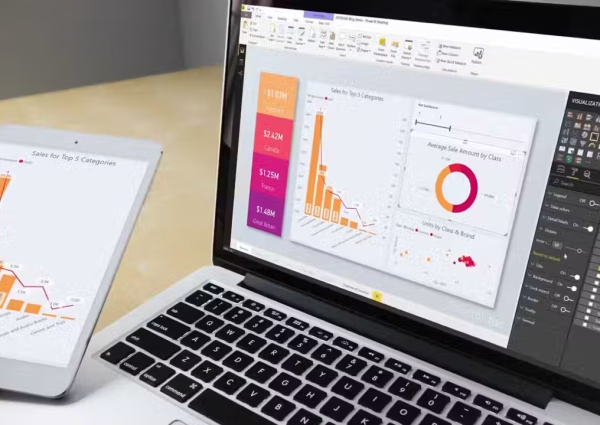Start
16 of June
Duration
24 hours
Schedule
to be defined
About the Training

Objetives
- Understand the basic concepts of Business Intelligence and how Power BI fits into this context;
- Learn techniques to clean, transform, and prepare data for analysis;
- Master the creation of efficient data models for analysis;
- Explore methods to calculate and interpret key metrics in data;
- Know and apply different types of visualizations and themes to improve data communication;
- Adapt and optimize reports for mobile devices;
- Learn licensing options and manage Power BI Service;
- Understand how to ensure data security and effectively share reports;
- Explore integrations with other tools.
Recipients
This course is aimed at professionals who wish to use the program as a tool for data import, processing, and analysis, with responsibilities in managing teams and clients, as well as the general public.
Prerequisites
It is recommended to use two monitors.
Program
Chapter 1: Introduction to Power BI
Introduction to the course
- Introduction of the trainer and trainees.
- Presentation of the course contents.
- Clarification of the course objectives.
- Explanation of the evaluation methodology.
Business Intelligence e Power BI
- Introduction to business intelligence and Power BI.
- Understanding the Power BI ecosystems (desktop, service, and mobile).
- Presentation of case studies.
- Installation and configuration of Power BI.
- Exploration of the Power BI interface.
Chapter 2: Semantic Model
Data Processing
- Data lifecycle.
- Data import. Connection to different data sources.
- Introduction to Power Query and M language to clean and transform data.
- Advanced Power Query operations.
Data Modeling
- Data modeling concepts (e.g., star schema).
- Creating relationships between tables. Understanding different types of relationships (one-to-many, many-to-many).
- Introduction to DAX language (Data Analysis Expressions).
- Creating calculated tables and columns using DAX.
- Introduction to the Tabular Editor tool.
Metrics
- Filter context vs. row context.
- Implementing metrics in DAX.
- Case study on advanced DAX functions.
- Use cases of advanced DAX functions (time intelligence and iterators).
- Introduction to the DAX Studio tool.
Chapter 3: Visualization
Visuals and Themes
- Best practices for developing effective and impactful visualizations.
- Different types of visuals (charts, cards, maps).
- Enhancing visualizations with formatting options and themes.
- Implementing interactive features such as drill-downs and cross-filtering.
- Introduction to custom visuals and their incorporation into reports.
Power BI for Mobile Applications
- Design for mobile applications.
Chapter 4: Administering Power BI
Power BI Service Administration
- Power BI licensing options.
- Management of workspaces, semantic models, and reports in Power BI Service.
- Creation and sharing of reports and apps.
- Power BI Gateway for scheduled refreshes.
Security and Sharing
- Configuration of security parameters and access management.
- Implementation of row-level security (RLS).
Chapter 5: Integration and Advanced Features
Integration and advanced features
- Integration of Power BI with PowerPoint, SharePoint, and Teams.
- Introduction to Power BI Embedded and the Power BI API.
- Q&A functionality.
Chapter 6: Case Studies
Solving exercises with real problems
Teacher

Ana Antunes graduated in 2017 with a Bachelor’s degree in Mathematics from the University of Minho, Portugal, and completed a Master’s degree in Systems Engineering at the same university in 2019. She also holds a Postgraduate degree in Data Analysis for Business from the Polytechnic Institute of Cávado and Ave, and a PhD in Industrial and Systems Engineering from the University of Minho. Since August 2023, she has been a collaborator at Data CoLAB as a Data Analyst. Her professional experience also includes research positions at the ALGORITMI and 2Ai research centers. She is also a guest assistant at the University of Minho in the fields of applied statistics and data intelligence.

Course within the scope of DGERT certification integrated in area 481 – Computer science


